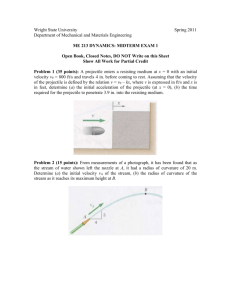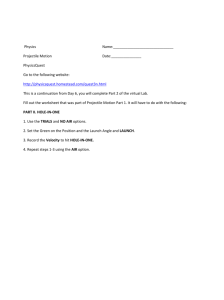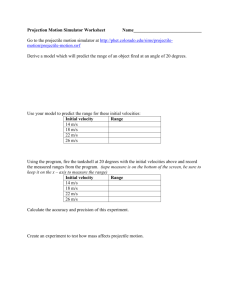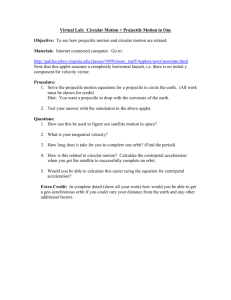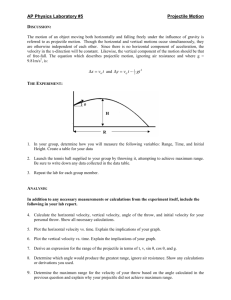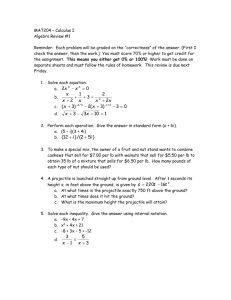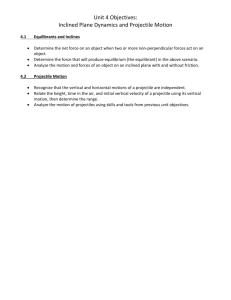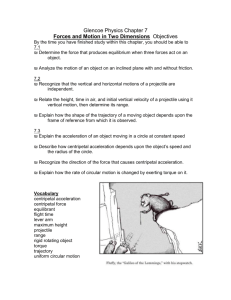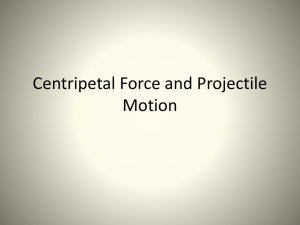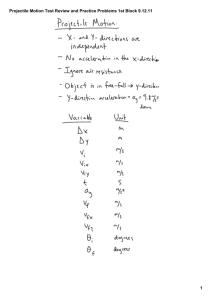PhUnit 2 with LEP- FINAL (6-20-08)
advertisement
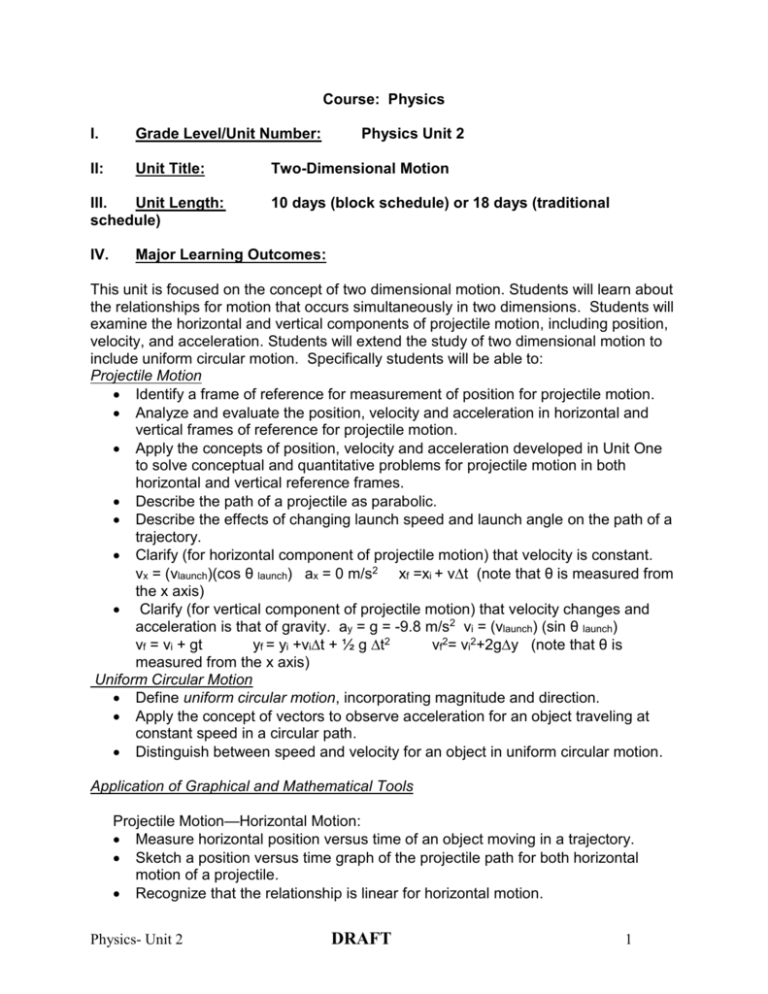
Course: Physics I. Grade Level/Unit Number: II: Unit Title: III. Unit Length: schedule) IV. Physics Unit 2 Two-Dimensional Motion 10 days (block schedule) or 18 days (traditional Major Learning Outcomes: This unit is focused on the concept of two dimensional motion. Students will learn about the relationships for motion that occurs simultaneously in two dimensions. Students will examine the horizontal and vertical components of projectile motion, including position, velocity, and acceleration. Students will extend the study of two dimensional motion to include uniform circular motion. Specifically students will be able to: Projectile Motion Identify a frame of reference for measurement of position for projectile motion. Analyze and evaluate the position, velocity and acceleration in horizontal and vertical frames of reference for projectile motion. Apply the concepts of position, velocity and acceleration developed in Unit One to solve conceptual and quantitative problems for projectile motion in both horizontal and vertical reference frames. Describe the path of a projectile as parabolic. Describe the effects of changing launch speed and launch angle on the path of a trajectory. Clarify (for horizontal component of projectile motion) that velocity is constant. vx = (vlaunch)(cos θ launch) ax = 0 m/s2 xf =xi + vt (note that θ is measured from the x axis) Clarify (for vertical component of projectile motion) that velocity changes and acceleration is that of gravity. ay = g = -9.8 m/s2 vi = (vlaunch) (sin θ launch) vf = vi + gt yf = yi +vit + ½ g t2 vf2= vi2+2gy (note that θ is measured from the x axis) Uniform Circular Motion Define uniform circular motion, incorporating magnitude and direction. Apply the concept of vectors to observe acceleration for an object traveling at constant speed in a circular path. Distinguish between speed and velocity for an object in uniform circular motion. Application of Graphical and Mathematical Tools Projectile Motion—Horizontal Motion: Measure horizontal position versus time of an object moving in a trajectory. Sketch a position versus time graph of the projectile path for both horizontal motion of a projectile. Recognize that the relationship is linear for horizontal motion. Physics- Unit 2 DRAFT 1 Identify the slope of the line as the change in position over time (velocity) and the y-intercept as the initial position for the given time interval. Note that the slope of position, time for horizontal motion is constant and thus velocity is constant. Recognize that a constant velocity means that acceleration for horizontal motion is zero! Projectile Motion—Vertical Motion: Measure vertical position versus time of an object moving in a trajectory. Sketch a position versus time graph of the projectile path for vertical motion of a projectile. Recognize that the relationship for position versus time is parabolic for vertical motion. Identify the slope of the line as the change in position over time (velocity) and the y-intercept as the initial position for the given time interval. Note that the slope of position, time for horizontal motion is not constant and thus velocity is not constant. Recognize that a parabolic position versus time graph means that acceleration is constant for vertical motion! a v x f xi vit 1 at 2 t 2 2 2 where a = g v f vi 2ax V. Content Objectives Included (with RBT Tags): COMPETENCY GOAL 1: The learner will develop abilities necessary to do and understand scientific inquiry. 1.01 Identify questions and problems that can be answered through scientific investigations. (RBT B2, B3, C2, C3) Physics- Unit 2 DRAFT This goal and these objectives are an integral part of each of the other goals. In order to measure and investigate scientific phenomena, students must be given the opportunity to design and conduct their own investigations in a safe laboratory. The students should use questions and models to formulate the relationship identified in their investigations and then report and share those finding with others Students will be able to: Develop questions for investigation from a given topic or problem. 2 1.02 Design and conduct scientific investigations to answer questions about the physical world. • Create testable hypotheses. • Identify variables. • Use a control or comparison group when appropriate. • Select and use appropriate measurement tools. • Collect and record data. • Organize data into charts and graphs. • Analyze and interpret data. • Communicate findings. (RBT C2, C3, C4, C5, C6) 1.03 Formulate and revise scientific explanations and models using logic and evidence to: • Explain observations. • Make inferences and predictions. • Explain the relationship between evidence and explanation. (RBT B2, B6, C2, C6) 1.04 Apply safety procedures in the laboratory and in field studies: • Recognize and avoid potential hazards. • Safely manipulate materials and equipment needed for scientific investigations. (RBT B3, C3) 3.01 Analyze and evaluate projectile motion in a defined frame of reference. (RBT B4, C3, B4) Physics- Unit 2 Distinguish and appropriately graph dependent and independent variables. Discuss the best method of graphing/presenting particular data. Use technology resources such as graphing calculators and computers to analyze data. Report and share investigation results with others. Use questions and models to determine the relationships between variables in investigations. Use evidence from an investigation to support a hypothesis. Predict safety concerns for particular experiments o Electricity o Projectiles Relate physics concepts to safety applications such as: o Transportation: seat belts, air bags, speed… Short circuits, circuit breakers, fire hazards Resolve vectors into vertical and horizontal components: a c b a 2 b 2 c2 sin a c b cos c DRAFT 3 3.02 Design and conduct investigations of two-dimensional motion of objects. (RBT C6 ,D5) 3.03 Analyze and evaluate independence of the vector components of projectile motion. (RBT C3) 3.04 Evaluate, measure, and analyze circular motion (RBT B3 , C3) Physics- Unit 2 tan a b Evaluate the motion of a projectile both horizontally and vertically. Recognize that the horizontal component of velocity does not change (neglecting air resistance). Recognize that the vertical component of velocity does change due to gravity at the rate of 9.8m/s2 downward. Select appropriate measurements for an investigation of projectile motion. Identify factors that may affect results. Predict and measure the path of the projectile including horizontal range, maximum height, and time in flight (such as a projectile launched horizontally or from the ground at a given angle). Recognize that vector components are independent of each other. Apply the equations of uniform velocity to the horizontal component. Apply the equations of accelerated motion to the vertical component of velocity. Relate height, time in air and initial vertical velocity (such as a projectile launched horizontally or from the ground at a given angle). Relate range of projectile, time and initial horizontal velocity (such as a projectile launched horizontally or from the ground at a given angle). Relate height and time in the air to the initial vertical velocity Relate range of projectile to time in flight and initial horizontal velocity Recognize that an object may move with constant speed but changing velocity. Recognize that the directions of the velocity and acceleration vectors are perpendicular to each other. Understand that centripetal acceleration is a consequence of the changing velocity due to change in direction. Design and conduct investigations of circular motion. Experimentally verify the proportional relationships described in 3.06. Combine proportional relationships into a single equation. Calculate velocity using radius or circumference of the circle and time to complete one or more cycles. Calculate centripetal acceleration as the velocity squared DRAFT 4 3.05 Analyze and evaluate the nature of centripetal forces. (RBT B3, C3) 3.06 Investigate, evaluate and analyze the relationship among: • Centripetal force. • Centripetal acceleration. • Mass. • Velocity. • Radius. (RBT C6, D4) Honors (RBT C6, D4) 2 divided by the radius: ac vr Evaluate and understand that a net force is required to change the direction of a velocity vector. Understand that for uniform circular motion the net force is called the centripetal force. Understand that the centripetal force is not the result of circular motion but must be provided by an interaction with an external source. Evaluate the direction of the force and acceleration vectors as pointing to the center of the circle in the case of constant speed but not constant acceleration Design and conduct an investigation of circular motion. Apply the proportional relationship between force and speed squared when radius is constant. Apply the inverse relationship between force and radius when speed is constant. Apply the formula for centripetal force as mass times centripetal acceleration using the following equations: 2 ac vr 2 Fc mrv Suggested Honors Project: Bottle Rockets VI. English Language Development Objectives (ELD) Included: NC English Language Proficiency (ELP) Standard 4 (2008) for Limited English Proficiency Students (LEP)- English Language learners communicate information, ideas, and concepts necessary for academic success in the content area of science. Suggestions for modified instruction and scaffolding for LEP students and/or students who need additional support are embedded in the unit plan and/or are added at the end of the corresponding section of the lessons. The amount of scaffolding needed will depend on the level of English proficiency of each LEP student. Therefore, novice level students will need more support with the language needed to understand and demonstrate the acquisition of concepts than intermediate or advanced students. Physics- Unit 2 DRAFT 5 VII. Materials/Equipment Needed: Most of the activities for this unit use inexpensive and simple materials. Those materials can be found here. Meter sticks String Compasses Rulers Blank paper Protractors Measuring tape Golf balls/marbles VIII. Rulers with troughs (to be used as ramps Stopwatches Small boxes or soup cans Toy dart guns Small blocks of wood Masking tape Duct tape Photogates and LabPros (optional) Soccer balls Rubber stoppers Small hollow tubes (6-10 cm) Dental floss (or other strong string) washers Detailed Content Description: Please see the detailed content description for each objective in the Physics Support Document. The link to this downloadable document is in the Physics Standard Course of Study at: http://www.ncpublicschools.org/curriculum/science/scos/2004/27physics IX. Unit Notes: Overview of Unit Two This unit is focused on the concept of two-dimensional motion. Students will learn about the relationships for motion that occurs simultaneously in two dimensions. Students will examine the horizontal and vertical components of projectile motion, including position, velocity, and acceleration. Students will extend the study of two-dimensional motion to include uniform circular motion. The Unit Guide below contains the activities that are suggested to meet the Standard Course of Study (SCOS) Goals for Unit Two. The guide includes activities, teacher notes on how to implement the activities, and resources relating to the activities which include language objectives for LEP (Limited English Proficient) students. Teachers should also consult the Department of Public Instruction website for English as a Second Language at: http://www.ncpublicschools.org/curriculum/esl/ to find additional resources. If a teacher follows this curriculum (s)he will have addressed the goals and objectives of the SCOS. However, teachers may want to substitute other activities that teach the same concept. Teachers should also provide guided and independent practice from the textbook or other resources. Physics Support Document Teachers should also refer to the support document for Physics at http://www.ncpublicschools.org/curriculum/science/scos/2004/27physics for the detailed Physics- Unit 2 DRAFT 6 content description for each objective to be sure they are emphasizing the specified concepts for each objective. Reference Tables The North Carolina Physics Reference Tables were developed to provide essential information that should be used on a regular basis by students, therefore eliminating the need for memorization. It is suggested that a copy be provided to each student on the first day of instruction. A copy of the reference tables can be downloaded at the following URL: http://www.ncpublicschools.org/docs/curriculum/science/scos/2004/physics/referenceta bles.pdf Essential Questions for Unit Two: Essential questions are those questions that lead to student understanding. Students should be able to answer these questions at the end of an activity. Teachers are advised to put these questions up in a prominent place in the classroom. The questions can be answered in a journal format as a closure. 1. Compare and contrast the processes of vector resolution and vector addition. 2. How do the vertical and horizontal components of a projectile’s velocity change? 3. How can the trajectory of a projectile be predicted? 4. How do linear and projectile motion relate to each other? How are they different? 5. How can an object moving at constant speed experience an acceleration? 6. How do you evaluate the centripetal acceleration of an object? 7. How is a force applied to create circular motion? 8. How do mass, velocity, and radius relate to centripetal force? 9. Why is centrifugal force a fictitious quantity in physics? 10. How would you design a lab to measure the relationships between mass, velocity, radius, and centripetal force? Safety No object should be thrown at another person at any time unless part of a lab activity. Hard-toed shoes should be worn in physics labs. Read all instructions before starting the lab activity. If lab equipment appears to be malfunctioning, contact the science teacher immediately. All students should be aware of what others are doing when lab activities are taking place. Keep lab area as clean as possible. Physics- Unit 2 DRAFT 7 Modified Activities for LEP Students Those activities marked with a have a modified version or notes designed to assist teachers in supporting students who are English language learners. Teachers should also consult the Department of Public Instruction website for English as a Second Language at: http://www.ncpublicschools.org/curriculum/esl/ to find additional resources. Computer Based Activities Several of the recommended activities are computer based and require students to visit various internet sites and view animations of various biological processes. These animations require various players and plug-ins which may or may not already be installed on your computers. Additionally some districts have firewalls that block downloading these types of files. Before assigning these activities to students it is essential for the teacher to try them on the computers that the students will use and to consult with the technology or media specialist if there are issues. These animations also have sound. Teachers may wish to provide headphones if possible. Web Resources The web resources provided on this page were live links when the unit was designed. Please keep in mind that as individuals make changes to websites, it is possible that the websites may become inactive. These resources are provided to supplement the activities in the unit. Some of the resources can be used as to supplement your teacherled discussions by projecting them for the class. Other activities require students to have access to computers. Support for all students from Physics (Giancoli) on vectors and two dimensional motion. http://lectureonline.cl.msu.edu/~mmp/kap3/cd This applet simulates projectile motion. 060.htm To fire the cannon, click or drag in the black area to establish the angle of the shot, or type an angle in the angle field. Next, choose a muzzle velocity for the shot. The data of each of your shots will be stored for later reference. http://www.cabrillo.edu/~dbrown/tracker/ Tracker is a free video analysis software download which allows analysis of digital video. One example is Ball Toss which tracks a tossed ball with a point mass. http://cwx.prenhall.com/giancoli/chapter3/del uxe.html Physics- Unit 2 DRAFT 8 http://www.forgefx.com/casestudies/prenticeh This interactive 3D simulation allows all/ph/catapult/catapult.htm students to work on the development of a virtual catapult, capable of launching giant paintballs. Using the Design and Test methodology, students must create their catapult so that it is capable of achieving the required tasks. These tasks include shooting paintballs for distance, height, and strength. http://hippocampus.org/Physics A wonderful site with video presentations, labs, and other materials—all free and all of great quality. http://www.vjc.moe.edu.sg/fasttrack/physics/ Animations for both circular motion and projectile motion. http://phet.colorado.edu/new/simulations/sim Join the ladybug in an exploration of s.php?sim=Ladybug_Revolution rotational motion. Rotate the merry-goround to change its angle, or choose a constant angular velocity or angular acceleration. Explore how circular motion relates to the bug's (x,y) position, velocity, and acceleration using vectors or graphs. http://physics.doane.edu/physicsvideolibrary/ These basketball clips show a basic free default.html#projectile throw type shot. They are intended to show projectile motion. Also included is a soccer kick from the back of a truck and video of a shuttlecock Physics- Unit 2 DRAFT 9 http://www.saintmarys.edu/~rtarara/LAB.html These are separate modules in a new series of laboratory simulations designed to serve as both pre and post lab tools. Typical data can be generated and analyzed. FREEFALL: This simulation uses the Pasco time of flight apparatus to time vertically falling balls-a small golf ball or a large, light, plastic ball. Timing is done with the Pasco smart timer. This experiment is designed to familiarize students with the concepts of acceleration by having them plot height versus time data. CENTRIPETAL FORCE: Based on the most common equipment setup, this animation follows the basic experimental procedures for determining the rotational parameters for measuring centripetal force. This animation is more of a 'cartoon' than most of the others (rotational animations are difficult) but the apparatus is reasonably well created. http://gbs.glenbrook.k12.il.us/Academics/gbs sci/phys/Class/vectors/vectoc.html http://wps.prenhall.com/esm_walker_physics _2/0,7966,802031-,00.html http://id.mind.net/~zona/mstm/physics/mecha nics/vectors/introduction/introductionVectors. html This site offers excellent background material on vectors and projectiles. Vector chapter presentation offers good background for teachers and students. Good introduction to vectors offers a great overview. X. Global Content: Aligned with 21st Skills: One of the goals of the unit plans is to provide strategies that will enable educators to develop the 21st Century skills for their students. As much as students need to master the NCSOS goals and objectives, they need to master the skills that develop problem solving strategies, as well as the creativity and innovative thinking skills that have become critical in today’s increasingly interconnected workforce and society. The Partnership for 21st Century Skills website is provided below for more information about the skills and resources related to the 21st Century classroom. http://www.21stcenturyskills.org/index.php?option=com_content&task=view&id=27&Ite mid=120 Physics- Unit 2 DRAFT 10 NC SCS Physics 21st Century Skills Communication Skills Goal 1, 3.01-3.06 Conveying thought or opinions effectively Goal 1, 3.01-3.06 When presenting information, distinguishing between relevant and irrelevant information Goals 1-8, 3.04 Explaining a concept to others Interviewing others or being interviewed Computer Knowledge Goals 1-8, esp. Using word-processing and Goal 1, 3.04 & database programs 3.05 Goals 1-8, esp. Developing visual aides for Goal 1, 3.02 & presentations 3.05 Goal 1, 3.02 Using a computer for communication 3.02 Learning new software programs Goals 1-8, 3.033.05 Goals 1-8, esp. Goal 1, 2.04, 3.02, 3.05, 4.07, 6.04, 7.01, Goal 8, 3.03 Goals 1-8, 3.01 Employability Skills Assuming responsibility for own learning Persisting until job is completed Working independently Developing career interest/goals Goal 1, 3.01, Responding to criticism or 3.02, 3.04, 3.06 questions Information-retrieval Skills Goal 1. 3.01-3.03 Searching for information via the computer Goal 1 Goals 1-8, 3.013.06 Physics- Unit 2 Searching for print information Searching for information using community members Language Skills - Reading Following written directions DRAFT Activity Questions in all Laboratory Activities Data collection in all Lab Activities Projectiles at an Angle Circular Motion Circular Motion Investigation of Projectile Motion Investigation of Projectile Motion Circular Motion Exploring Projectiles Vector Treasure Hunt Questions in all Lab Activities Investigation of Projectile Motion Most of the activities can be presented as opportunities for 11 Goals 1-8, 3.013.06 Goals 1-8, 3.03 Goal 1, 3.03 Goals 1-8 Identifying cause and effect relationships Summarizing main points after reading Locating and choosing appropriate reference materials Reading for personal learning Language Skill - Writing Using language accurately Organizing and relating ideas when writing Proofing and Editing Goals 1-8 Goals 1-8, 3.013.06 Goals 1-8, esp. Goal 1, 3.01-3.06 Goals 1-8, esp. Synthesizing information from Goal 1, 3.01-3.06 several sources Goal 1 Documenting sources Developing an outline 1.04, 3.01-3.06 Writing to persuade or justify a position Creating memos, letters, other forms of correspondence Teamwork Goal 1, 2.04, Taking initiative 3.02, 3.06, 4.06, 6.01, 6.04, 7.01, 8.02, 8.03, 8.04 Goal 1, 2.04, Working on a team 3.02, 3.06, 4.06, 6.01, 6.04, 7.01, 8.02, 8.03, 8.04 Thinking/Problem-Solving Skills Goals 1-8, 3.01- Identifying key problems or 3.06 questions Goals 1-8, 3.01- Evaluating results 3.06 Goals 1-8 Developing strategies to address problems 1.01, 2.04, 3.02, Developing an action plan or 3.06, 4.06, 6.01, timeline 6.04, 7.01, 8.02- Physics- Unit 2 DRAFT students to follow written directions. The teacher will have to work with most students to develop this skill over time. “Explain” and “Evaluate” in all lab activities Exploring Projectiles Investigation of Projectile Motion “Explain” and “Evaluate” in all lab activities “Evaluate” in all lab activities “Explain” and “Evaluate” in all lab activities “Evaluate” in all lab activities All Lab Activities All Lab Activities All Lab Activities All Lab Activities 12 04 Physics- Unit 2 DRAFT 13 Teacher’s Guide- Vector Treasure Hunt This activity is designed to help students understand the graphical method of vector addition, and to understand the idea that the order in which the vectors are added has no effect on the final outcome. Day One of the activity should be done after the graphical method has been introduced, but before the algebraic component (mathematical) method has been introduced. Day Two of this activity should either be done after the algebraic method is introduced, or question #1 from the post lab should be omitted. Language (ELP) Objectives for LEP Students: Print a copy of MapQuest directions from school to a familiar destination and make an overhead as a demo. After students have completed the graphical directions of their map, have them write out the specific directions from the initial to the final destination. Engage Introduce this activity by telling the students that they will be participating in a treasure hunt, but that there is a trick…they have to create the directions for another group to follow. Utilizing a treasure hunt increases student interest in vectors. Explore Students are asked to work together to create a series of directions for other students to follow. Students should be encouraged to be creative with the directions to keep things interesting. As the students are working on their directions, the teacher should circulate to ensure that they are writing clear, concise directions. Before the students complete the second part of the activity, it is also recommended that the teacher provide some kind of “treasure” to be found at each landmark (ending point). Explain The development of the “maps” (graphical addition of the vectors) gives students the opportunity to practice the graphical method. The shuffling of the cards raises the question of whether or not the order of the vectors matters and allows an opportunity for the students to prove to themselves that the outcome is not affected. This is one reason why it is recommended that there is an actual “treasure” at the end. Finding the treasure is proof to the students that the order did not matter. Key to pre- and post-lab questions Remember, pre-lab questions are designed to get students to start thinking about the concepts involved in the activity. Students should not always be expected to know the correct answers to the pre-lab questions. 1. A vector must have a magnitude and a direction. 2. Student answers will vary, but most will think that the order does matter. Physics- Unit 2 DRAFT 14 1. There are far too many vectors to resolve each into components and then add them to find the resultant. 2. After completing the activity, students should recognize that the order of the directions did not matter because their resultant displacement was the same as the group that created the directions. Physics- Unit 2 DRAFT 15 Vector Treasure Hunt Objectives Use appropriate measurements (distances and angles) to provide a list of written directions Use graphical addition to create a map of your directions Interpret the directions written by a different group Use graphical addition to create a map of the other group’s directions Pre-Lab Questions 1. In order to have a vector quantity, which two types of data must be obtained? 2. Do you think that the order in which vectors are added makes a difference in the final outcome? Why or why not? Materials Compass Ruler Protractor Meter stick or measuring tape Paper and pencil Blank paper Physics- Unit 2 DRAFT 16 Lab Instructions – Day One 1. To complete this activity in a timely manner, you will need to convert between meters and number of footsteps. Choose one person in your lab group to be the “walker”, and have them practice walking so that they move exactly one meter. Suggestion: walk heel to toe and count how many “feet” are in a meter. 2. After your walker has mastered this, choose a starting point, and record that. You should be very specific. Tell the other group where to start, and what they should see at that point. Then you may begin working on your set of directions. You should have at least 15 individual vectors, but no more than 20. Each direction should be written on a separate index card. You may include some fun, silly directions, but the important part is the part that will be mapped: the vectors. Your final direction should have them stopping at some recognizable campus landmark, but DO NOT write the name of the landmark in the directions. 3. After you have completed your list, use the graphical method of vector addition to make a map of your directions. You should clearly label the resultant displacement on the map, and record the landmark they should be facing at the end. Record the magnitude and direction of the resultant displacement on the bottom of the page. Lab Instructions – Day Two 1. Obtain a set of instructions from another group, and find their starting point. You should now proceed to follow their directions until you get to the end. Make a note of any directions that are unclear. 2. Using the graphical method of vector addition, make a map of the directions you just walked. Be sure to find the magnitude and direction of your resultant displacement. Record the name of the landmark that you find at the end. Post-lab Questions 1. Why might it be inappropriate to use the algebraic component (mathematical) method of vector addition for this activity? 2. The sets of index cards containing the directions were shuffled before they were passed out. Did the order of the directions make any difference in the final outcome? Why or why not? Physics- Unit 2 DRAFT 17 Physics- Unit 2 DRAFT 18 Physics- Unit 2 DRAFT 19 Physics- Unit 2 DRAFT 20 Teacher Guide: Exploring Projectiles Notes to Teacher: This activity should be done after students have a good grasp of both graphical and algebraic methods of vector addition Students are taken outside, where they are told to design a method to determine the distance between two points which are separated by a large obstacle, such as a building Class time can be saved by introducing the activity and showing the students the two points on one day, and having them design their procedure for homework. Then they can complete the lab on a different day. Language (ELP) Objectives for LEP Students: Define key terms; magnitude, direction, and vector. Describe verbally or in paragraph form the relationship between these terms and provide an example. ENGAGE: In the pre-lab discussion, ask students to raise their hand if they play a sport of some type. Then ask them to raise their hand if they play a sport that involves a projectile. This is an excellent time to define a projectile as any object that travels through the air and accelerates only under the force of gravity. Only a few sports such as Track and Field, curling, and biking do not incorporate a projectile at some point. EXPLORE: This experiment is designed to emphasize to the student the effect of increased speed on the distance the projectile travels horizontally. Another important emphasis is that the time in the air is independent of the initial speed if the projectile leaves the table at an angle of zero degrees with the horizontal. Check to make sure all groups have the launch device away from the edge of the table so that the projectile leaves the table horizontally. If computers are available students may use an online stopwatch program from Clemson University http://phoenix.phys.clemson.edu/labs/stopwatch.html OR they may use a program that may be loaded into their calculator http://www.ticalc.org/pub/83plus/basic/programs/ EXPLAIN: Students provide answers to questions Physics- Unit 2 DRAFT 21 ELABORATE: The last question asks students to elaborate. EVALUATE: The Challenge part of the experiment allows students to evaluate how well they took data. Answers to Questions: 1) The greater the angle of the ramp, the larger the value of distance 2 measures. 2) Possible answers are height of the table, mass of the ball, length of the ruler. 3) The times should not be very different. The initial speed is all in the x direction and as such does not affect the way the object falls. The only affect of increasing the speed is to increase the horizontal distance that the ball travels before hitting the floor. 4) The height of the table affects the time the ball is in the air and that does not change. For the “Challenge”, deduct only a small number of points from the grade if the target is missed. Timing with a stopwatch is difficult. Physics- Unit 2 DRAFT 22 EXPLORING PROJECTILES NAME: What affects the path of a projectile? The motion of a projectile is more complicated as it may have both horizontal motion and vertical motion. We are going to explore the falling object by making several measurements. You will need the following: a golf ball or marble, a ruler that has a trough or track down the middle (most wooden and some plastics ones have this), a stopwatch, a meterstick and a box or empty soup can. Develop a plan. On your lab table, place the ruler about 10 cm from the edge. Find a way to elevate the end of the ruler that is the farthest away from the end of the table. Also find a way to change the height from which you release the golf ball or marble so that you are not pushing it. Describe your plan here: Distance 1(height) Distance 2 Delegate your roles: One person should release the ball carefully and consistently. Another should measure the height of the table and distance 2 carefully and consistently. The hardest role is using the stopwatch to time from the instant the ball leaves the edge of the table until it hits the floor. The last person must carefully record the data in a neat and accurate manner. That person must create a table in which to record data. What Should I Measure? Please measure height of ball above table before it is released. Measure the height of the table and the distance the ball travels horizontally (distance 2). Measure the time the ball is in the air from table to floor. Physics- Unit 2 DRAFT 23 DATA: Place your Chart here. Label the columns as you feel appropriate. TRIAL 1 2 3 4 5 What did we discover? 1) Does the height of the release ramp affect the horizontal distance (distance 2)? 2) Name two constants in the setup of your experiment. 3) Are the times the projectile was in the air very different for each trial? Why or why not? 4) What affects the time the ball was in the air if it always rolls straight off the table? CHALLENGE: When you have completed your measurements and recorded them in the chart, your teacher will present your group with a challenge. Your teacher will pick one of your heights and place a box or can at the horizontal position you measured. You must hit the object at the position the teacher selects. You shall loose ______ points every time you must repeat the roll. Good Luck! Teacher Notes: Deduction of ______________ points Physics- Unit 2 DRAFT 24 TEACHER GUIDE FOR Projectiles at an Angle Notes to Teacher: This activity is an introductory activity for projectile motion. It helps students visualize the connection between constant horizontal motion and accelerating vertical motion. The students roll golf balls down a ramp (wooden ruler) changing the height of the ruler. The ball leaves the ruler and rolls across the table until it rolls off the edge. Students record the time in the air for various angles of the ruler. Language (ELP) Objectives for LEP Students: Think-pair –share with another student or the whole class the procedure for the projectile launching activity. Write a summary of activity and how this relates to this unit on vectors. ENGAGE Start the lesson by tossing a tennis ball to different students in the class. Vary the angle of launch and try to gently throw the ball at about the same speed. Changing the angle of launching the dart presents real challenges in making predictions for some students. Some sample questions which may help are included below. (1) What angle do you predict will produce the greatest horizontal distance? (2) Does the angle affect the speed of the dart? (3) Does the angle affect the time in the air? (4) Why does a baseball/softball coach caution against “side-arming” a baseball? EXPLORE One of the most difficult parts of the lab is to measure the speed of the dart as it leaves the dart gun. Students must also find a stable method of creating the correct angles. Walk around the classroom and interact with the students as they explore possible methods. One way to do this is to ask “what is the advantage of using an ‘object’s name’ at the end of your block? EXPLAIN Students will answer the questions at the end of the lab. Evaluate Physics- Unit 2 DRAFT 25 Ask students to compare their answers with each other before turning in their labs. Suggestions: 1) Buy dart guns at a dollar store. 2) Pencils, books, doorstops (wedges), etc can be used to elevate one end of the block. 3) An easy way to measure the speed of the dart is to shoot the dart horizontally from a two meter height. Stand on a chair or stairway. Measure height of launch and also the horizontal distance the dart travels. An example is provided; Example: x= 8 = vot and -8 = 0t – 0.5 (9.8) t2 Using the second equation, solve for t: t= 1.26. Substitute into the first equation to find Vo. Vo = 7.6 m/s. This is a powerful dart gun! Height= 2m Physics- Unit 2 Range=8 m DRAFT 26 Projectiles at an Angle Name The Big Question: How does the angle of launching a projectile affect where it lands? What Is Your Prediction? Equipment: a dart gun with a dart, two blocks of wood of the same height, masking tape, ruler or meter stick, protractor, duct tape, stop watch, photogates (optional) Set-up: Tape the gun flat to the top of one block using duct tape. The trigger should be free of the tape. Mark the position of the projectile block. Load the dart into the gun. Your Challenge: 1. Find a way to measure the speed of your dart. 2. Place an object of your choice under the right end of the projectile block so that the following angles are created with the table: 20°, 30°, 45°, 60° and 70°. 3. Predict how far away from the right end of the projectile block the target block must be placed so that the dart will hit it in the middle of the block. 4. Hit the target block in the middle of the block. DATA: Describe your method of measuring the speed of your dart. Show calculations below for your speed: Show calculations in the space below for predicted range. For 20° Physics- Unit 2 For 30° DRAFT 27 For 45° For 60° And for 70° Your Data Angle of Launch (in degrees) Predicted horizontal distance (m) (Also called Range) Actual horizontal distance (m) Number of tries to hit the middle 20° 30° 45° 60° 70° Physics- Unit 2 DRAFT 28 Record your observations below about the process. What did you discover? Give at least two observations relating to the physics of the experiment. How does the angle of launching a projectile affect where it lands? Physics- Unit 2 DRAFT 29 Teacher’s Guide- How fast can you kick? This activity is designed to be used towards the end of the study of projectiles launched at an angle. To be able to complete the calculations, students will need to have a good understanding of how to solve problems where they are given the initial velocity and are asked to calculate quantities such as maximum height, time in the air, and horizontal displacement. This lab is structured so that they do the exact opposite process. They will start with two pieces of data; the horizontal distance traveled and the total time in the air, and use that information to work backwards and find the ball’s total initial velocity. Engage: This activity engages students by asking them to figure out the speed at which they can kick a ball. Setting up a friendly competition within the class can help to pique student interest in the activity. Because this activity uses the reverse process of the typical projectile motion problem, it provides an opportunity to really gauge student understanding of projectiles. Explore: Requiring students to develop their own procedure allows an opportunity for them to collaborate with each other and to really think about the types of data to collect. Explain: During the process of designing a procedure, group members will be required to express and evaluate their own ideas. Often group members will disagree about the types of data to collect or about the process needed to collect that data. These conflicts force them to discuss ideas and provide an opportunity for them to clarify misconceptions for each other. Elaborate: This activity requires students to link the concepts of projectile motion that they have learned to a real problem, and to use those concepts to develop an answer to that problem. Evaluate: The process of designing an experiment allows students to demonstrate their understanding of projectiles, as well as to apply that knowledge to solve a problem. Answer Key Pre-lab 1. time, horizontal distance, some students will say they need the angle 2. Many students will say that they do need the angle, even though they don’t because it can be calculated at the end. Often, as they are doing their final calculations they will realize that they never need that value. 3. Answers will vary 4. human error with the timer, wind and other external factors Post Lab Physics- Unit 2 DRAFT 30 1. a. if the angle is increased, the vertical speed increases, and the horizontal speed decreases b. because total time in the air only depends on the initial vertical velocity and acceleration due to gravity, as the angle increases, time in the air increases c. because vertical displacement only depends on the initial vertical velocity and acceleration due to gravity, balls kicked at a high angle will have a higher maximum height than those kicked at a low angle d. because the horizontal displacement depends on both the horizontal component of velocity and the total time in the air, a simple relationship does not exist. Physics- Unit 2 DRAFT 31 How fast can you kick? Projectile Lab Objectives: design an efficient, accurate experiment collect, record, and analyze data choose and apply appropriate equations apply the concepts learned in class to determine the initial velocity and maximum height of a soccer ball Pre-lab questions 1. What types of data will you need to collect? 2. What equipment will you need to complete this activity? 3. Do you need to measure the angle at which the ball is kicked? Why or why not? 4. Briefly outline the methods you intend to use to complete this experiment. 5. What are some possible sources of error in this experiment? What can be done to reduce error? Physics- Unit 2 DRAFT 32 Data Trial One Trial Two Trial Three Calculations For each trial, find the following: horizontal speed, maximum height, initial vertical speed, total initial velocity (including the angle of the kick). Trial One Trial Two Trial Three Physics- Unit 2 DRAFT 33 Post-Lab Questions 1. Explain how the angle at which the ball was kicked affected each of the following: a. Horizontal and vertical speeds b. Time in the air c. Maximum height d. Horizontal displacement Physics- Unit 2 DRAFT 34 Teacher Guide: An Investigation of Projectile Motion ENGAGE: The activity starts with “What do you think?” to make students think about what they already know? EXPLORE: Students explore angles of launch, mass and shape, and initial velocity. EXPLAIN: Each exploration is followed by a request to explain what is seen and discovered ELABORATE: Students should share their findings after this activity in a class post-lab discussion with the teacher. EVALUTE: In the post-lab discussion, evaluate the findings discussed. Make a list from the student’s comments and clear up any misconceptions. Physics- Unit 2 DRAFT 35 An Investigation of Projectile Motion Introduction In this activity, you will use a computer simulation to investigate the variables of projectile motion. This activity is to: Investigate the launch angle, initial velocity, and size & shape of a projectile in order to explain how these variables affect the projectile’s motion. Materials Computer Animation from PheT (either downloaded or online) http://phet.colorado.edu/new/simulations/index.php?cat=Top_Simulations Background a) What do you think? Think about a ball flying through the air. There are many possible things that affect the trajectory (path) of the projectile. The most important of these factors are the angle, the initial velocity, and the size & shape of the object being fired. Think about each variable and describe how it may affect a projectile in motion with or without air resistance. b) Now Experiment and Observe. Go to the PHET website http://phet.colorado.edu, click on “Simulations,” scroll down, and select the “Projectile Motion” simulation. You will investigate how the three variables from part a) affect projectile motion. You want to focus particularly on the maximum height and maximum range of the projectile. Air Resistance should not be checked. Your Conclusions: 1. How does the angle affect projectile motion? Change the angle option to read 20o and then click fire, and observe the resulting motion path. When it finishes, repeat the instructions, but use angles of 30o, 45o, 60o, 70o. Compare the motion paths of each angle, and write your observations below. For 20: Physics- Unit 2 DRAFT 36 For 30: For 45: For 60: For 70: 2. How does initial velocity affect projectile motion? Reset to DEFAULT conditions specified above and click the “Erase” button (this should erase all your motion paths from above). Now change the initial velocity to 15 m/s and click fire, and observe the path. When it finishes, repeat the instructions, but use 20 m/s, 25 m/s, 30 m/s, 35 m/s, and 40 m/s. Determine any pattern, and write your observations below. 3. Will size and shape of the projectile affect the path? If so, then how? Reset the parameters to DEFAULT conditions and click on the “Erase” button. Change only the objects in the trajectory and observe the pattern 4. How does size & shape affect projectile motion if there is air resistance? Reset the parameters to default and click on the “Erase” button. Now repeat part 3, but check the air resistance box. Observe the motion paths and record your observations below. What affects the path? Physics- Unit 2 DRAFT 37 Teacher Guide- Circular Motion at Constant Speed Language (ELP) Objectives for LEP Students: Write out a procedure for investigating the factors that affect centripetal force o verbally share their procedure with partner/class o listen to verbal presentations from partner/class and write a summary comparing and contrasting varying procedures. ENGAGE: If you are up to the demonstration of swinging a cup of water in a vertical circle to illustrate the nature of centripetal force then this is a good place to do so right before the lab. Take a strong plastic cup (clear if possible) and tie a strong string on it as shown below. Ask students to draw a diagram of the circle and the forces acting on the cup. Demonstrate the use of the apparatus and emphasize that they must not hold onto the string. The washers at the end of the string must provide the only tension along the string. (Use a large paper clip to hook the washers to the string) EXPLORE: Students may require your help in selecting variables. As the teacher, you may wish to ask them before the lab to help you create a list of possible variables that will affect the number of washers (the centripetal force) needed to keep the speed constant and maintain a constant radius for a single trial. They should suggest mass at the end of the string (rubber stoppers of varying mass) and radius of the path. EXPLAIN: Students are asked to explain their choices for the variables to investigate. ELABORATE: The question “What did you conclude about your data?” should force students to examine how consistent and informative their data is. They should notice a trend— increases, decreases or keeps the same—in the affect on centripetal force. ELABORATE: Physics- Unit 2 DRAFT 38 “What was the relationship between the variables that you selected?” asks for a conclusion from each student about the results they obtained. EVALUATE: The statement “Create a graph of your two variables to verify your statement” requires a graphical comparison/evaluation of data. Physics- Unit 2 DRAFT 39 Circular Motion at Constant Speed NAME: When an object travels in a circular path at constant speed, the force is always directed toward the center of that path. Such a force is designated as a “CENTRIPETAL FORCE” which translates as “center seeking” force. What affects the path of an object in circular orbit? Forces that change direction but do not change speed always act perpendicular to the path of the object and toward the center of the circular path that is created. We are going to explore some of the variables for objects in circular orbits at constant speed. You will need the following: 1 or more (up to 4) rubber stoppers of the same size, a tube (the casing of an ink pen with both ends removed is a possibility) of 6-10 cm in length, 2 meters of dental floss or other small, strong string, 20 washers or masses of 50 g, 100 g, 200 g, etc. masses, meter stick, and a stopwatch. rubber stopper tube washers Procedure: Develop a plan. You should investigate one factor that affects the centripetal force of the object moving in a circular path. Whether you select mass, velocity, or radius, it must be clear that all other variables should be constant. Which of the variables do you think should be the easiest to keep the same (so that they become constants)? How do you propose to maintain these variables as constants? What did you choose to investigate? Force as a change in _____________________? Physics- Unit 2 DRAFT 40 Present Your Data: Create a Data Chart: TRIAL 1 2 3 4 5 What did you conclude about your data? What was the relationship between the variables that you selected? Create a graph of your two variables to verify your statement. Physics- Unit 2 DRAFT 41 EVALUATION: Summative Evaluation: On the following page are sample test items obtained from the WIZARD test bank developed by eduware™ that can be used to allow students to assess their understanding and abilities and allow the teacher to evaluate the students understanding of key concepts and skill development for this unit. Physics- Unit 2 DRAFT 42 Physics- Unit 2 DRAFT 43 Physics- Unit 2 DRAFT 44 Physics- Unit 2 DRAFT 45 Physics- Unit 2 DRAFT 46 Physics- Unit 2 DRAFT 47
